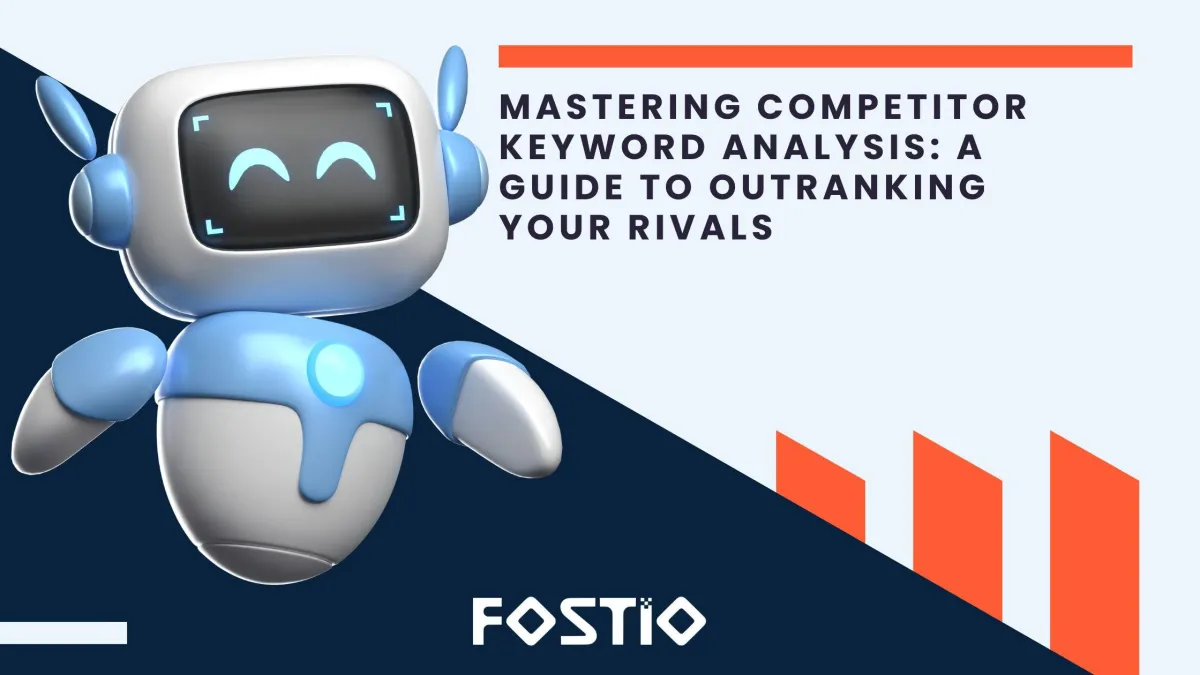
Mastering Competitor Keyword Analysis: A Guide to Outranking Your Rivals
In the ever-competitive world of digital marketing, the ability to outshine your competitors hinges on one thing—knowing what they’re up to. Enter competitor keyword analysis. Think of it as your secret weapon for uncovering their strategies and staying one step ahead.
But what exactly is it? Why does it matter? And how can you do it like a pro? Buckle up, because we’re diving deep into the world of competitor keyword analysis.
What Is Competitor Keyword Analysis?
Why Is Competitor Keyword Analysis So Important?
How to Perform Competitor Keyword Analysis
Step 1: Identify Your Top Competitors
Step 3: Find Their Top-Performing Keywords
Once you’ve chosen your tool, look for:
Step 4: Analyze Their Content Strategy
Step 6: Optimize Your Strategy
Tips to Crush Competitor Keyword Analysis
How Fostio Can Help You Win the Keyword Battle
1. How often should I perform competitor keyword analysis?
2. What’s the difference between organic and paid keywords?
3. Can I analyze competitors without paid tools?
What Is Competitor Keyword Analysis?
Competitor keyword analysis is the process of identifying and analyzing the keywords your competitors are targeting in their content and advertising. It’s like peeking into their playbook to see which search terms are driving their traffic.
By doing this, you can:
Find gaps in their strategy.
Discover new keyword opportunities.
Understand what works (and what doesn’t) in your niche.
Why Is Competitor Keyword Analysis So Important?
Let’s face it: SEO isn’t just about ranking; it’s about outranking. And to do that, you need to know what your competitors are up to.
Here’s why competitor keyword analysis matters:
Stay Ahead of the Curve: Get insights into emerging trends in your industry.
Maximize ROI: Focus on high-value keywords instead of wasting time on low-impact ones.
Identify Content Gaps: Find topics your competitors missed.
Understand User Intent: Learn what your audience is searching for and align your content accordingly.
How to Perform Competitor Keyword Analysis
Ready to uncover the secret sauce? Follow these steps to ace competitor keyword analysis.
Step 1: Identify Your Top Competitors
Before you analyze, you need to know who your competition is. Start by:
Searching for your primary keywords and noting down the top-ranking domains.
Using tools like SEMrush or Ahrefs to find competitors in your niche.
Step 2: Use the Right Tools
Tools are your best friend when it comes to competitor analysis. Here are some favorites:
1. Ahrefs - Keyword gap analysis, backlink tracking, and content insights.
2. SEMrush - Comprehensive keyword analysis and competitor research tools.
3. Moz - Domain authority comparison and keyword tracking.
4. Google Keyword Planner - Free tool for basic keyword research and volume insights.
Step 3: Find Their Top-Performing Keywords
Once you’ve chosen your tool, look for:
Organic Keywords: These are driving traffic to your competitors’ sites.
Paid Keywords: Ads they’re running on platforms like Google Ads.
Branded Keywords: Terms specific to their products or services.
Step 4: Analyze Their Content Strategy
Look at their top-ranking content:
What keywords are they targeting?
Are they using long-tail or short-tail keywords?
What type of content (blogs, videos, infographics) do they use to rank?
Step 5: Spot Keyword Gaps
A keyword gap analysis shows keywords your competitors rank for, but you don’t. This is a goldmine for new content ideas.
Step 6: Optimize Your Strategy
Take everything you’ve learned and refine your approach:
Create better content targeting the same keywords.
Explore low-competition keywords for quick wins.
Improve your on-page SEO and link-building strategies.
Tips to Crush Competitor Keyword Analysis
Focus on Long-Tail Keywords: They’re less competitive and often have higher conversion rates.
Monitor Competitor Ads: Use tools like SpyFu to see which keywords they’re bidding on.
Keep Tabs on Trends: Keywords that perform today might not tomorrow.
Don’t Ignore User Intent: Align your content with what users are actually looking for.
Revisit Regularly: SEO is a marathon, not a sprint. Keep refining your strategy.
How Fostio Can Help You Win the Keyword Battle
Feeling overwhelmed? Don’t worry—Fostio has got your back. With Fostio’s all-in-one marketing platform, you can:
Conduct competitor analysis seamlessly.
Automate keyword tracking and updates.
Create high-performing content with AI tools.
Generate detailed analytics to measure your progress.
And the best part? You can try it all with a 14-day free trial. Ready to dominate your niche? Let’s make it happen with Fostio.
Conclusion
Competitor keyword analysis is like having a roadmap to success in your industry. It’s not just about copying what works for others; it’s about doing it better. Armed with the right tools, strategies, and platforms like Fostio, you can turn insights into action and climb the ranks faster than ever.
FAQs
1. How often should I perform competitor keyword analysis?
At least quarterly, but monthly is better if your industry is fast-paced.
2. What’s the difference between organic and paid keywords?
Organic keywords drive unpaid search traffic, while paid keywords are used in PPC campaigns.
3. Can I analyze competitors without paid tools?
Yes, but paid tools provide more comprehensive insights and save time.
4. How do I prioritize keywords?
Focus on high-volume, low-competition keywords with strong relevance to your business.
5. What makes Fostio’s platform unique for SEO?
Fostio offers an all-in-one solution, combining keyword tracking, AI-driven content creation, and robust analytics—all in one place.
Start your competitor keyword analysis journey today and watch your rankings soar. With a little effort and the right tools, you’ll be the one your competitors are chasing!



